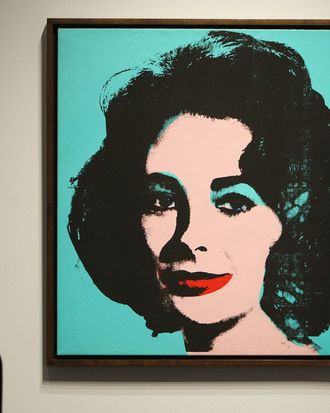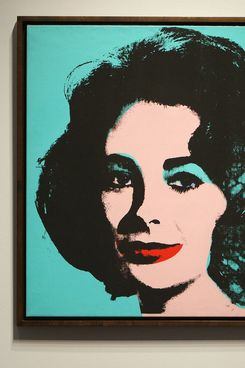

Elizabeth Taylor died today, and part of something American is gone but not gone. She’s something many know and love, something many more don’t know at all. I am in the latter camp. Perhaps because of who I am, when I was born, or my dopeyness about movie stars, for me Elizabeth Taylor is mainly a beauty with black hair and gaudy eye makeup in Cleopatra, a friend of Michael Jackson’s, and a tremendous AIDS activist.
Most of all, for me, however, Elizabeth Taylor is Andy Warhol’s paintings of her. When I see her, I see those amazing pictures, and my mind is flooded with ideas of image manipulation, overexposure, divadom, iconicity, victimhood, vampire, parody, celebrity, cult heroes, lost soul, loving freakiness, queerness, and fearlessness.
Andy is in the air we breathe; Liz was in the air he breathed. Yet Warhol and Taylor are still looked at suspiciously, like beautiful losers or uncouth, ungainly winners. In his own lifetime Warhol was lambasted as “this weird little faggot,” “a creep,” “abnormal,” and “homosexual.” Willem de Kooning famously railed at him, “You’re a killer of art.” Would Warhol have been as belittled had he been straight, more “normal”? Would Taylor have been so parodied had she not embraced the gay community? As critic Robert
Pincus-Witten wrote, “Andy was forged on the anvil of the straight… [but was] armoured by his languid and defensive swish.” This languidness and armor drew a lot of fire. It still does.
Andy loved women and the power of the feminine, and the women he loved most and best were Marilyn, Jackie, and Liz. Many of the paintings made in his heyday, between 1962 and 1965, were of them. Like the women themselves, the pictures of Liz exude a primitive hit of graphic power, stunning color, seething glamour, repressed sexuality, and flawed beauty.
Warhol painted Taylor from his own photos, and as both the young star of National Velvet and the later Liz of Cleopatra, queen of high camp, patron saint of the strange. One masterpiece, the almost monochrome Blue Liz As Cleopatra (1963), depicts her fifteen times. It’s a sort of blue movie, a silent film made of still pictures and moving photo-booth strips. You can almost feel how bad Cleopatra was, in the ways Warhol allows the images to overlap and appear off-register and piled-up. The film sprockets slip before your eyes.
Then there are the many single pictures of her, with lips wandering all over the canvas, hair as helmet, blue-eye-shadowed, pink-skinned. She’s a modern religious icon or Medusa. It’s as if something about Taylor’s instability and image made Warhol mirror her future in his pictures. The colors go from silver-screen sleekness to drag-queen yearbook pic to fabulously garish.
Warhol began the Liz pictures while she was recovering from her emergency 1961 tracheotomy. We already see the person who would marry and divorce again and again, go in and out of rehab, gain 50 pounds, appear in tacky commercials. In Warhol’s pictures of Taylor lurk her tragic sexuality, tragicomic survival, excess, and ridiculous love. Also in there somewhere is the future hero of gay rights—a commando monarch dynamo in the battle against AIDS. Warhol’s work and Liz exist in some supernal realm beyond reason. Both of them make you feel like art can change the world.




